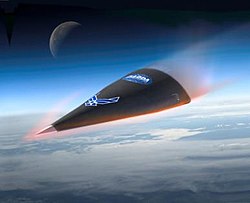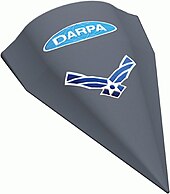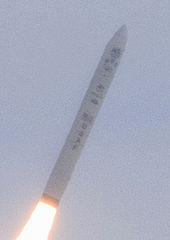
A scramjet is a variant of a ramjet airbreathing jet engine in which combustion takes place in supersonic airflow. As in ramjets, a scramjet relies on high vehicle speed to compress the incoming air forcefully before combustion, but whereas a ramjet decelerates the air to subsonic velocities before combustion using shock cones, a scramjet has no shock cone and slows the airflow using shockwaves produced by its ignition source in place of a shock cone. This allows the scramjet to operate efficiently at extremely high speeds.

The NASA X-43 was an experimental unmanned hypersonic aircraft with multiple planned scale variations meant to test various aspects of hypersonic flight. It was part of the X-plane series and specifically of NASA's Hyper-X program developed in the late 1990s. It set several airspeed records for jet aircraft. The X-43 is the fastest jet-powered aircraft on record at approximately Mach 9.6.

The Boeing X-37, also known as the Orbital Test Vehicle (OTV), is a reusable robotic spacecraft. It is boosted into space by a launch vehicle, then re-enters Earth's atmosphere and lands as a spaceplane. The X-37 is operated by the Department of the Air Force Rapid Capabilities Office, in collaboration with United States Space Force, for orbital spaceflight missions intended to demonstrate reusable space technologies. It is a 120-percent-scaled derivative of the earlier Boeing X-40. The X-37 began as a NASA project in 1999, before being transferred to the United States Department of Defense in 2004. Until 2019, the program was managed by Air Force Space Command.

The Minotaur is a family of United States solid fuel launch vehicles derived from converted Minuteman and Peacekeeper intercontinental ballistic missiles (ICBM). They are built by Northrop Grumman via contract with the Air Force Space and Missile Systems Center's Space Development and Test Directorate (SMC/SD) as part of the Air Force's Rocket Systems Launch Program which converts retired Intercontinental Ballistic Missiles into space and test launch systems for U.S. government agencies.

The DARPA FALCON Project is a two-part joint project between the Defense Advanced Research Projects Agency (DARPA) and the United States Air Force (USAF) and is part of Prompt Global Strike. The first part of the project aims to develop a Small Launch System (SLS) capable of accelerating hypersonic gliding weapons as well as launching small satellites into Earth orbit. The second part of the project aims to develop Hypersonic Weapon Systems (HWS): a short term high performance hypersonic gliding weapon previously named the X-41 Common Aero Vehicle (CAV) that could be launched from Expendable Launch Vehicles (ELV), Reusable Launch Vehicles (RLVs), Hypersonic Cruise Vehicles (HCV), or Space Maneuvering Vehicles (SMP), and a long term hypersonic cruise aircraft named the Hypersonic Cruise Vehicle (HCV). This two-part program was announced in 2003 and continued into 2006.

The Boeing X-51 Waverider is an unmanned research scramjet experimental aircraft for hypersonic flight at Mach 5 and an altitude of 70,000 feet (21,000 m). The aircraft was designated X-51 in 2005. It completed its first powered hypersonic flight on 26 May 2010. After two unsuccessful test flights, the X-51 completed a flight of over six minutes and reached speeds of over Mach 5 for 210 seconds on 1 May 2013 for the longest duration powered hypersonic flight.
Scramjet programs refers to research and testing programs for the development of supersonic combustion ramjets, known as scramjets. This list provides a short overview of national and international collaborations, and civilian and military programs. The USA, Russia, India, and China (2014), have succeeded at developing scramjet technologies.

Hypersonic flight is flight through the atmosphere below altitudes of about 90 km at speeds greater than Mach 5, a speed where dissociation of air begins to become significant and high heat loads exist. Speeds over Mach 25 have been achieved below the thermosphere as of 2020.

Minotaur IV, also known as Peacekeeper SLV and OSP-2 PK is an active expendable launch system derived from the LGM-118 Peacekeeper ICBM. It is operated by Northrop Grumman Space Systems, and made its maiden flight on 22 April 2010, carrying the HTV-2a Hypersonic Test Vehicle. The first orbital launch occurred on 26 September 2010 with the SBSS satellite for the United States Air Force.

USA-212 was the first flight of the Boeing X-37B Orbital Test Vehicle 1, an American robotic vertical-takeoff, horizontal-landing (VTHL) spaceplane. It was launched aboard an Atlas V rocket from Cape Canaveral on 22 April 2010, and operated in low Earth orbit. Its designation is part of the USA series.
Conventional Prompt Strike (CPS), formerly called Prompt Global Strike (PGS), is a United States military effort to develop a system that can deliver a precision-guided conventional weapon strike anywhere in the world within one hour, in a similar manner to a nuclear ICBM. Such a weapon would allow the United States to respond far more swiftly to rapidly emerging threats than is possible with conventional forces. A CPS system could also be useful during a nuclear conflict, potentially replacing the use of nuclear weapons against up to 30% of targets. The CPS program encompasses numerous established and emerging technologies, including conventional surface-launched missiles and air- and submarine-launched hypersonic missiles, although no specific CPS system has yet been finalized as of 2018.

The Alpha Draco missile, also known as Weapons System 199D (WS-199D), was an experimental ballistic missile developed by McDonnell Aircraft in the late 1950s to investigate the aerodynamic physics of the boost-glide reentry trajectory. Three test flights were conducted in 1959, of which two were successful.
The DARPA XS-1 was an experimental spaceplane/booster with the planned capability to deliver small satellites into orbit for the U.S. Military. It was reported to be designed to be reusable as frequently as once a day, with a stated goal of doing so for 10 days straight. The XS-1 was intended to directly replace the first stage of a multistage rocket by taking off vertically and flying to hypersonic speed and high suborbital altitude, enabling one or more expendable upper stages to separate and deploy a payload into low Earth orbit. The XS-1 would then return to Earth, where it could ostensibly be serviced fast enough to repeat the process at least once every 24 hours.

The Lockheed Martin SR-72, colloquially referred to as "Son of Blackbird", is an American hypersonic UAV concept intended for intelligence, surveillance and reconnaissance (ISR) proposed privately in 2013 by Lockheed Martin as a successor to the retired Lockheed SR-71 Blackbird. In 2018, company executives said an SR-72 test vehicle could fly by 2025 and enter service in the 2030s.
The DF-ZF is a Chinese hypersonic glide vehicle (HGV), previously denoted by the Pentagon as WU-14 and currently officially operational on October 1, 2019, in the 70th anniversary of the People's Republic of China. The DF-ZF is designed to be mounted on a DF-17, a medium range ballistic missile specifically designed to carry the DF-ZFs.

Non-ballistic atmospheric entry is a class of atmospheric entry trajectories that follow a non-ballistic trajectory by employing aerodynamic lift in the high upper atmosphere. It includes trajectories such as skip and glide.

The Avangard is a Russian hypersonic glide vehicle (HGV) that can be carried as an MIRV payload by the UR-100UTTKh, R-36M2 and RS-28 Sarmat heavy ICBMs. It can deliver both nuclear and conventional payloads. The Avangard is reportedly capable of travelling at re-entry speeds.

A hypersonic weapon is a weapon capable of travelling at hypersonic speed, defined as between 5 and 25 times the speed of sound or about 1 to 5 miles per second.
Hypersonix Launch Systems is an Australian space startup developing scramjet and scramjet-based access-to-space technology. In particular, the company is focused on reusable "green-fuelled" launch technology. The company specialises in hypersonic vehicle and scramjet engines to provide sustainable and affordable access to space.


















